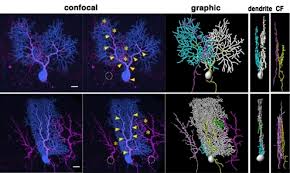A team of brain researchers from various institutions has made significant strides in understanding the complexity of the human brain through a comparative analysis of nerve cells found in mice and humans. The study, recently published in the journal Communications Biology, focused on Purkinje cells (PCs) in the cerebellum.
Purkinje cells are a type of neuron known for their intricate structure, featuring a large number of dendritic spines. In their research project, the team aimed to delve into the evolutionary history of the human brain and unravel the origins of its exceptional complexity and cognitive capabilities.
To achieve this, the researchers closely examined PCs collected from both human and mouse brains, employing advanced microscopy techniques. Additionally, they developed models to compare the functioning of these cells in each species, ultimately identifying several key differences.
One of the most notable distinctions was the number of dendrites found in human PCs, which was approximately 7.5 times greater than that of mouse PCs. Moreover, human PCs were larger overall. The team discovered that the higher dendritic complexity in human PCs allowed for the creation of larger, more intricate, and sophisticated neural architectures.
By comparing their models, the researchers found that the size and complexity of human PCs provided the human brain with a greater capacity to process information in a given time frame compared to their mouse counterparts. The increased number of dendrites also enabled the construction of significantly more complex networks in humans compared to mice.
The research team thus proposes that the development of intricate neurons, such as PCs, played a critical role in enhancing the computational capacity of the human brain, ultimately contributing to human intelligence.
These findings shed light on the mechanisms underlying the evolution and development of the human brain, offering valuable insights into the factors that have led to its remarkable complexity and cognitive abilities. By understanding these intricate neural processes, researchers may pave the way for advancements in various fields, including neuroscience, artificial intelligence, and cognitive enhancement.
The investigation of Purkinje cells in mice and humans has allowed brain researchers to gain a deeper understanding of the evolutionary trajectory of the human brain. The enhanced computational capacity provided by the higher dendritic complexity and larger size of human Purkinje cells suggests a significant factor in the development of human intelligence. These findings contribute to the growing body of knowledge regarding the complexity of the human brain and have the potential to drive future breakthroughs in neuroscience and related disciplines.
*Note:
1. Source: Coherent Market Insights, Public sources, Desk research
2. We have leveraged AI tools to mine information and compile it.




